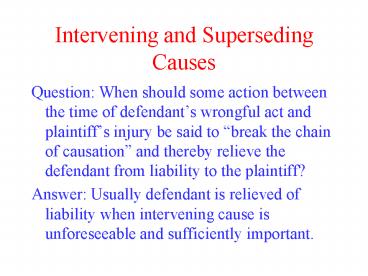Intervening and Superseding Causes - PowerPoint PPT Presentation
1 / 19
Title:
Intervening and Superseding Causes
Description:
plaintiff injured her knee. Mauney. Defendant's delivery truck on fire and likely to explode ... operates on her, causing her injuries to be much more severe ... – PowerPoint PPT presentation
Number of Views:182
Avg rating:3.0/5.0
Title: Intervening and Superseding Causes
1
Intervening and Superseding Causes
- Question When should some action between the
time of defendants wrongful act and plaintiffs
injury be said to break the chain of causation
and thereby relieve the defendant from liability
to the plaintiff? - Answer Usually defendant is relieved of
liability when intervening cause is unforeseeable
and sufficiently important.
2
Causal chains
- City of Lincoln
- Defendant negligently collides with plaintiffs
vessel, causing loss of navigating equipment gt - plaintiffs captain attempts to bring ship to
port gt - plaintiffs ship suffers damages.
3
Tuttle
Defendants train jumped the tracks negligently
and headed toward plaintiff --gt plaintiff
jumped out of the way to get to safety --gt
plaintiff injured her knee.
4
Mauney
- Defendants delivery truck on fire and likely to
explode gt - neighbors warn plaintiff -gt
- plaintiff trips over chair in her own place of
business in an effort to escape. - Is this a contributory negligence case in
disguise?
5
Security guard hypos
- Suppose a security guard at a shopping mall falls
asleep on the job. A criminal comes to the
shopping mall at night, and attacks a customer as
he is getting into his car. - Separately, an arsonist lights a gasoline truck
on fire in the mall parking lot, causing a fire
that injures a second customer.
6
Intervening criminal activity under the
Restatement
- Restatement (Second) section 448 and 449
- Intervening criminal acts break the chain of
causation unless the actor at the time of his
negligent conduct realized or should have
realized the likelihood that such a situation
might be created, and that a third person might
avail himself of the opportunity to commit such a
tort or crime.
7
California Cases
- Contrast Bigbee (page 448) with Ann M. case (to
be discussed next week) - What does language of foreseeability mask?
8
Two final hypos
- D injures P in an auto accident. P is taken to
the hospital, where a doctor negligently operates
on her, causing her injuries to be much more
severe than had a competent doctor operated.
Result?
9
Hypo 2(a)
- A gasoline truck owned by D oil company negligent
spills gasoline in the street. A, who is unaware
of the spilled gasoline, negligently tosses away
a match after lighting a cigarette. The match
ignites the gasoline, severely burning P who is
on an errand. Is D liable?
10
Hypo 2(b)
- Same facts, except A deliberately throws the
match in a desire to injure P.
11
Pure economic loss rule
- In the absence of property damage or personal
injury, plaintiff cannot recover for financial
losses.
12
Exception
- If the only kind of injury a defendant can
inflict upon a plaintiff is financial losses, the
economic harm rule does not apply.
13
Emotional distress damages
- Old rule required that the damages be parasitic
to other damage, usually resulting from physical
impact - Fear of false claims and difficulty of measuring
damages - Transitional rule required plaintiff to be in the
zone of physical danger to recover
14
Negligent infliction modern rule
- Direct victims may recover for negligent
infliction of emotional distress that is
sufficiently foreseeable. (Sometimes called
separate tort but treat it as negligence where
injury is emotional distress) - Still some important policy limits fear of AIDS,
cancer cases generally require to recover that
plaintiff be more likely than not to get the
disease.
15
NIED Bystander recovery
- Dillon test
- (1) plaintiff is located near the scene of the
accident rather than a distance from it - (2) the shock results from the direct emotional
impact upon plaintiff from the sensory and
contemporaneous observation of the accident, as
contrasted with learning of the accident from
others after its occurrence. - (3) whether plaintiff and the victim were closely
related, as opposed to the absence of a
relationship or a distant relationship.
16
When is it a bystander case and when a direct
victim?
- Why is Molien a direct victim case?
- Court says it depends upon whether defendant
assumed a direct duty to plaintiff. This is a
policy determination.
17
Contrast IIED bystander recovery
18
- Intentional infliction tortious conduct
- (1) Defendant engages in extreme and outrageous
conduct - (2) And intentionally (or recklessly) causes
- (3) severe emotional distress to the plaintiff
19
- Bystander additions
- If the tort if directed to a third person, add
- (4) by conduct directed to a member of
plaintiffs immediate family who is present at
the time or - (5) to anyone else present, if such distress
results in bodily harm.































